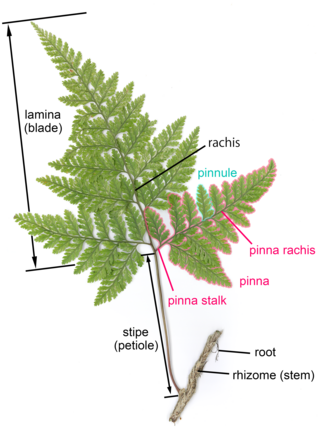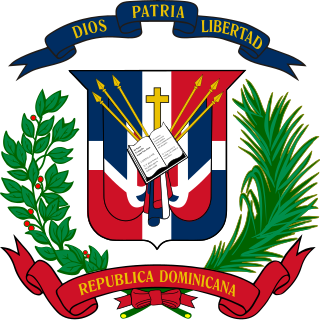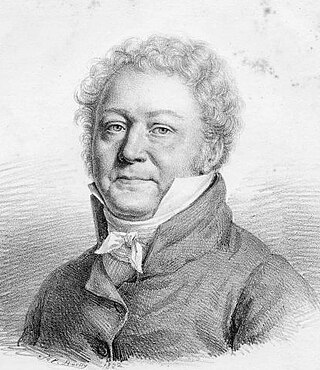
Palm Sunday is the Christian moveable feast that falls on the Sunday before Easter. The feast commemorates Christ's triumphal entry into Jerusalem, an event mentioned in each of the four canonical Gospels. Its name originates from the palm branches waved by the crowd to greet and honor Jesus as he entered the city. Palm Sunday marks the first day of Holy Week; in Western Christianity, this is the beginning of the last week of the solemn season of Lent, preceding Eastertide, while in Eastern Christianity, Holy Week commences after the conclusion of Great Lent.

A frond is a large, divided leaf. In both common usage and botanical nomenclature, the leaves of ferns are referred to as fronds and some botanists restrict the term to this group. Other botanists allow the term frond to also apply to the large leaves of cycads, as well as palms (Arecaceae) and various other flowering plants, such as mimosa or sumac. "Frond" is commonly used to identify a large, compound leaf, but if the term is used botanically to refer to the leaves of ferns and algae it may be applied to smaller and undivided leaves.

Rhopalostylis sapida, commonly known as nīkau, is a palm tree endemic to New Zealand, and the only palm native to mainland New Zealand.

Victorine-Louise Meurent was a French painter and a model for painters. Although she is best known as the favorite model of Édouard Manet, she was an artist in her own right who regularly exhibited at the prestigious Paris Salon. In 1876, her paintings were selected for inclusion at the Salon's juried exhibition, when Manet's work was not.
Raudondvaris is a town on the Nevėžis River in Kaunas district, Lithuania, 1 km (0.62 mi) west of Kaunas city municipality.

The coat of arms of the Dominican Republic features a shield in similarly quartered colors as the flag, supported by a bay laurel branch (left) and a palm frond (right); above the shield, a blue ribbon displays the national motto: Dios, Patria, Libertad. Below the shield, the words República Dominicana appear on a red ribbon. In the center of the shield, flanked by six spears, the front four holding the national flag, is a Bible which is open to John: 8:31–32 with a small golden cross above it. The coat of arms appears in the center of the flag of the Dominican Republic.

The southern yellow bat is a species of vesper bat that belongs to suborder microchiroptera (microbat) in the family Vespertilionidae. It is native to South, North and Central America, from the Rio Grande Valley of Texas in the United States to Argentina.

Guillaume Guillon-Lethière was a French neoclassical painter.

The palm branch, or palm frond, is a symbol of victory, triumph, peace, and eternal life originating in the ancient Near East and Mediterranean world. The palm (Phoenix) was sacred in Mesopotamian religions, and in ancient Egypt represented immortality. In Judaism, the lulav, a closed frond of the date palm is part of the festival of Sukkot. A palm branch was awarded to victorious athletes in ancient Greece, and a palm frond or the tree itself is one of the most common attributes of Victory personified in ancient Rome.

Normanbya is a monotypic genus of palms containing the single species Normanbya normanbyi, which is known by the common name black palm It is endemic to Queensland, Australia and is threatened by habitat destruction.

The Bernardine Cemetery, is one of the three oldest cemeteries in Vilnius, Lithuania. It covers about 38,000 square metres and has an estimated 14,000 burial sites. It was established in 1810 by the Bernardine monks of the Church of St. Francis of Assisi, just east of the city center in the Užupis district, and is situated on an embankment of the Vilnia river. Its development was a consequence of Tsarist authorities of the Russian Empire prohibiting burying the dead near churches. The residents of Vilnius moved the cemetery to what was then the outskirts of the city.

Jan Rustem was a painter of Armenian ethnicity who lived and worked in the territories of the Polish–Lithuanian Commonwealth. Primarily a portrait painter, he was commissioned to execute portraits of notable personalities of his epoch. For many years he was a professor at Vilnius University.

An Easter palm is a traditional Lithuanian and Polish symbolic decoration associated with Palm Sunday. Barbara Ogrodowska states that the ceremonial palm branch is the "most important attribute" of Palm Sunday in Poland. Communities of Polish emigrants, such as those in the United States, observe the tradition of making of Easter palms as well.

Kanuty Rusiecki was a Lithuanian painter.

Basketry of Mexico has its origins far into the pre Hispanic period, pre-dating ceramics and the domestication of crops. By the time the Spanish arrived, there were a number of indigenous forms, a number of which are still made today. These and products that the Spanish introduced form the combined tradition that remains today. Like other Mexican handcrafts, sales to tourists and collectors is important, but basketry is not as popular as other handcrafts. Basketry techniques and materials vary from region to region depending on the vegetation available, with important traditions in Sonora, State of Mexico, Michoacán, Veracruz, Oaxaca and the Yucatán Peninsula.

Wincenty Leopold Sleńdziński, or Vincas Slendzinskis in Lithuanian was a Polish-Lithuanian painter, primarily of portraits, in the Realist style.

Mystical Marriage of St Catherine of Alexandria with Niccoló Bonghi is an oil-on-panel painting by Lorenzo Lotto, executed in 1523, in the Collections of the Accademia Carrara, Bergamo, Italy.

Self-Portrait as a Female Martyr, is also known as the Self-Portrait as a Martyr Saint. This painting was created by the Italian female artist, Artemisia Gentileschi. This self-portrait was made around 1615 depicting the artist herself as a martyr. It is one of two paintings by Gentileschi painted with oil on a wood panel. This self-portrait is currently in a private collection in the United States.
Stebėkiai is a village in Panevėžys District Municipality, Lithuania. According to the 2011 census, it had no residents. It is located 4 kilometres (2.5 mi) from Vadokliai town.

Bolesław Michał Rusiecki (Lithuanian: Boleslovas Mykolas Ruseckas; was a Polish-Lithuanian painter and art collector.



















